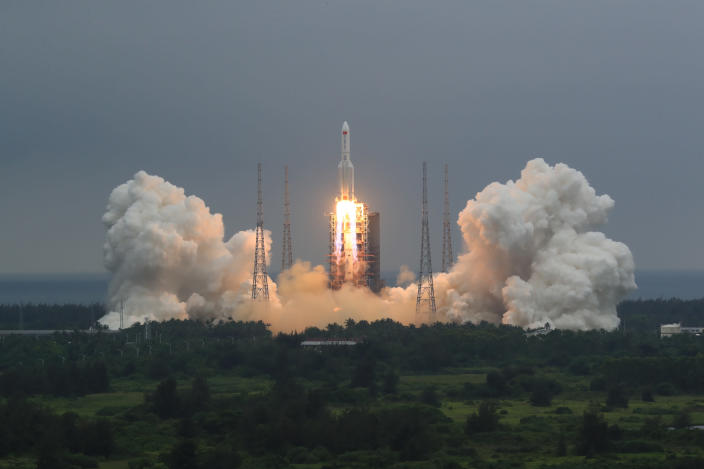A Long March 5B rocket carrying a platform for a Chinese space station lifts off from the Wenchang Spacecraft Launch Site in Wenchang, southern Hainan Province of China, in this April 29, 2021, file photo released by the China’s Xinhua News Agency.
The central rocket section that launched the 22.5-ton heart of the newest space station of China into orbit. It is scheduled to return to Earth on Saturday in an undisclosed location.
Tracking says falling China rocket will crash to Earth within hours – follow live https://t.co/YQ42ODNoZb
— The Independent (@Independent) May 8, 2021
The space agency of China said a central part of the largest rocket re-entered Earth’s atmosphere over the Maldives in the Indian Ocean early Sunday, with the majority of it burning up.
“An ocean reentry was always statistically the most likely,” Harvard astrophysicist Jonathan McDowell, who monitored the tumbling rocket segment, said on Twitter. China seems to have secured the bet… But it was always risky.”
According to China’s official Xinhua News Agency, the reentry happened at 7:24 p.m. Saturday, local time.
This survey also reported that “the vast majority of objects were burnt beyond recognition during the reentry period.”
Despite this, NASA Administrator Sen. Bill Nelson said, “It is clear that China is struggling to follow responsible expectations for their space debris.”
NASA administrator Bill Nelson’s statement on the #ChineseRocket:
“It is clear that China is failing to meet responsible standards regarding their space debris.”https://t.co/O3P0kXXeQ0 pic.twitter.com/hotM5b2ri1
— Michael Sheetz (@thesheetztweetz) May 9, 2021
Discarded rocket stages typically reenter the atmosphere shortly after liftoff, mostly over water, and do not enter orbit.
On April 29, the Tianhe, or Heavenly Harmony, the main module launched into space by the Long March 5B rocket. China intends to launch ten more rockets to place additional space station components into orbit. The nearly 30-meter-long (100-foot-long) stage will be among the largest pieces of space debris to hit Earth.
Also, The 18-ton rocket that crashed last May was the heaviest unregulated debris dropping since the former Soviet space station Salyut 7 in 1991.
Additionally, Tiangong-1, China’s first space station, crashed into the Pacific Ocean in 2016 after Beijing announced it had lost control. In 2019, the space agency oversaw the atmospheric decommissioning of its second station, Tiangong-2.
In March, debris from a Falcon 9 rocket launched by the American aerospace corporation SpaceX landed in Washington and along the Oregon coast. China had chastised after it launched a rocket to kill a defunct weather satellite in January 2007, resulting in a vast area of radioactive debris endangering satellites and other spacecraft.
Painting pictures with words and showing rather than telling is the underlying principle of my wholehearted artistic writing.







